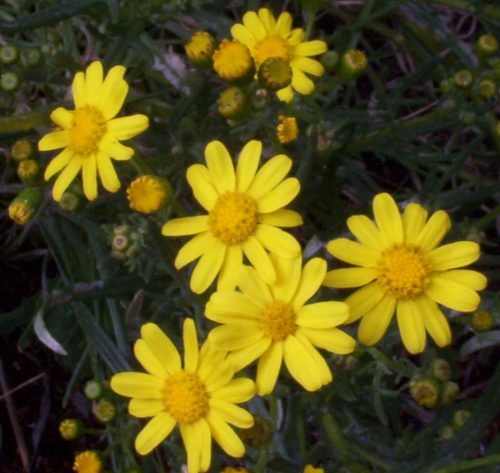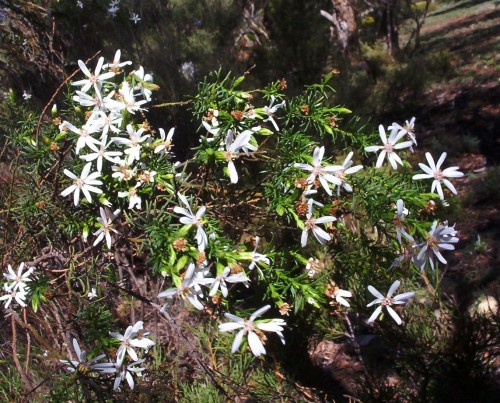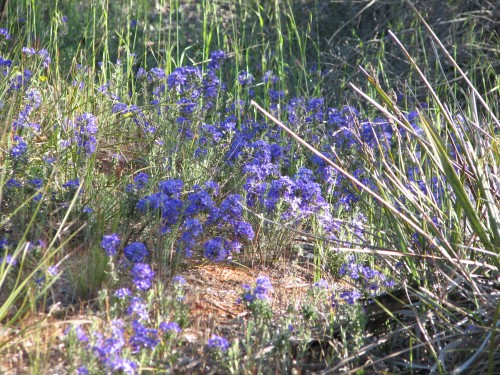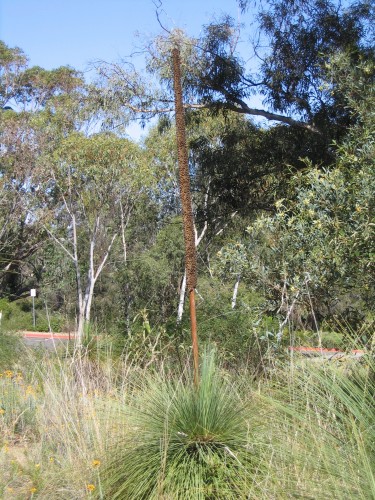Spring flowers: Senecio lautus, a native daisy

Native daisy Senecio lautus flowering in our small piece of scrub.
Why are you growing weeds? I was a bit taken a back because as far as I knew Senecio lautus was an Australian Native daisy. So what is a definition of a weed?
My understanding is that weeds:
- are introduced species from another continent, usually brought in by people knowingly or unknowingly eg. in the padding in saddles in the ‘olden days’.
- are introduced species which have become escapees from garden environments eg. watsonias and Acacia baileyana in the Adelaide Hills
- native species planted for a specific purpose which have escaped that particular environment
- native species which seed all over the place and take over garden beds. Some people don’t mind this but to others it is a nuisance and the plant is therefore a weed.
Senecio lautus may come into the latter category, but I don’t mind at all. Bring it on, I say. They flower among the mallee trees on our block, come up in pots where I don’t want them, flower prolifically along the South Eastern Freeway on the way to Adelaide and give a glorious glow of warmth on cold cloudy days.
They are easily pulled out if not wanted in a specific location. Some appear to be perennial up to 60-70cm tall, others flower at about 30cm, some require cutting back after flowering to maintain a neat bush. Many just appear to die back and re-shoot when it rains in early winter. I consider them worth having, but of course once you have one seed in the garden you are likely to have them next season whether you want them or not! Find out more about Senecio lautus.
I picked some yesterday morning in an experiment to see if they would last as a cut flower. I hadn’t bothered to try before. I will report back. One thing I did notice is that some flowers closed their petals last night.
Salt Tolerant Plants
An email came today asking for assistance with species that would grow in bore water with high salt readings. This is a difficulty for many in the mallee areas of South Australia and no doubt other parts of the country too. In many cases it becomes trial and error to see what would grow in such a situation, but some lists have been compiled by members of the Australian Plants Society which give a good starting point.
There are some things to consider.
- There is a need to ensure that watering is deep.
- Choose plants from areas which have the same rainfall situation ie same amount of rain, at the same time of year. This is to ensure that plants will get minimum exposure to the high salinity.
- If possible place highly desirable plants near an alternative water source, eg rain water, to get them well established without the saline water.
List of Australian Native Plants with salt tolerance.
1st Line Coast
Ground Covers, Climbers and Low Spreading Plants
Correa decumbens
Eremophila glabra prostrate cerise form
Eremopohila glabra prostrate red form
Grevillea ‘Seaspray’
Isolepis nodosa
Leuocophyta brownii
Rhagodia spinescens
Scaevola crassifolia
Templetonia retusa prostrate form
Shrubs 1-2m
Atriplex cinerea
Callistemon rugulosus
Eremophila calorhabdos
Eremophila glabra (Rottnest Island)
Hakea cycloptera
Olearia axillaries
Templetonia retusa
Westringia fruticosa
Shrubs over 2m.
Atriplex nummularia
Callistemon teretifolius
Hakea drupacea
Melaleuca nesophila
More lists will be available soon.
Olearia passerinoides
Olearia passerinoides is a mallee daisy and is quite a large bush with bright green leaves, different to many mallee daisies which often have grey green leaves. Although this is a shrub, to me it behaves as a perennial shrub, in that new growth appears along the older wood.
The bush has a tendency to become scruffy, with the leaves higher up the stems and the flowers also high. If it was cut back to the lower growths, it would have dense foliage and be a more compact plant, and I suspect the flowering would also be quite spectacular.
As usual, I promise myself that I will do this, and yet another season goes buy. Mine have just finished flowering, so out with the secateurs tomorrow, while I think of it.
Olearia passerinoides is drought, lime and frost tolerant. It has clusters of small white daisies and grows to 2-3m tall by about 1.5-2m wide if left to its own devices. Pruning will keep it to a more compact size.
Dampiera rosmarinifolia
Xanthorrhoea glauca ssp angustifolia (Grass Tree)
I found this plant in Canberra Botanic gardens in the bush garden with other grasses and daisies. I assume that it is native to the area around Canberra. I could not find ant direct information about the plant. Most of the time I scrabbled around the base of plants in the garden looking for the aluminium tag attached to the plant to read what the species was. Unfortunately, I forgot to check other plants in the area in case there was further information.
Judging by the type of soil and location, I suggest that this plant needs good drainage. It is obviously frost hardy as it was in an exposed situation. There was a saying amongst the Australian Plant Society members that if a plant grew in Canberra, it would survive any frost that formed in South Australia.


